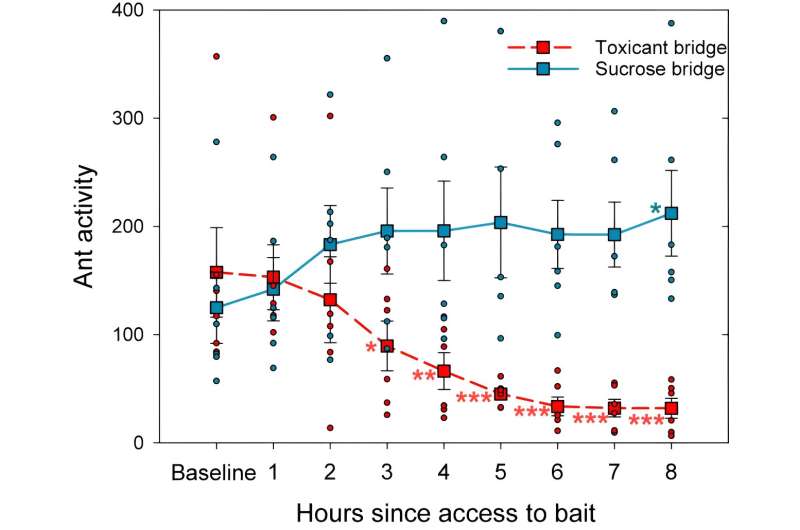This article has been reviewed according to Science X's editorial process and policies. Editors have highlighted the following attributes while ensuring the content's credibility:
fact-checked
peer-reviewed publication
proofread
Invasive ants selectively abandon toxic baits, evading our most effective eradication method

Invasive ants are economically costly and ecologically devastating, and most of our eradication attempts have failed. Now, researchers at the University of Buenos Aires and the University of Regensburg have discovered that these ants can evade the most ecological friendly and effective control method we have—toxic baits—by rapidly abandoning them before the ants can be killed.
The paper is published in the journal Communications Biology.
The costs of invasive ants are staggering: A recent study estimated it at 52 billion U.S. dollars. However, the ecological cost of ant invasions is perhaps worse. Invasive ants drive out native ants, destabilizing ecosystems and threatening vertebrates such as sea birds with extinction. Many countries have spent millions on control efforts, but two thirds of eradication attempts have failed. No one really knows why.
"I have been fighting ant infestations for years" said Dr. Roxana Josens, who led the study. "I would put toxic baits out to kill the ants, and they disappeared—but only where the baits were. The ants just on the other side of the wall from the bait were still very much alive. So I wondered: Am I really killing them, or are the ants outsmarting us?"
To test this, the researchers let Argentine ants feed from two separate food sources. More and more ants came, until hundreds of ants were feeding. Then, one of the food sources was switched for an identical one containing an insect toxin, which the ants nonetheless are extremely happy to eat. Within hours, the number of ants at the poison food started dropping, until within six hours only 20% were left. However, the number of ants on the non-poisoned food remained high.
"It's highly unlikely that this drop in feeding ants was because they were dying "says Daniel Zanola, who ran the experiment. "In the lab, we let ants drink this toxic food and watched them carefully—very few died within six hours."
The ants were also not becoming full—otherwise the non-toxic food source would also be losing ants. And further studies showed that the ants are not rejecting the toxic food because of its taste. Somehow, the ants were identifying the food as poisonous, and selectively abandoning it, thus evading the harmful effects.
"This is a big deal" says Dr. Tomer Czaczkes, who also worked on the study. "First, this might explain why we are failing to keep these invasive ants in check." But things might be worse than that. "This 80% reduction we see—that is very similar to a lot of the reductions reported for 'successful' control efforts. But were these past control efforts really killing the ants, or were they being evaded? We simply don't know. I guess it was a mixture of both."
"Recently, several researchers have found that ants have clever ways of defending themselves from natural enemies and pathogens" says Roxana. "It looks like they could be deploying their 'social immunity' to defend themselves against our baits too."
The team is now working hard on working out exactly how the ants are detecting and coordinating their defense. Perhaps soon we will know how to beat them.
More information: Daniel Zanola et al, Ants evade harmful food by active abandonment, Communications Biology (2024). DOI: 10.1038/s42003-023-05729-7
Journal information: Communications Biology
Provided by Universität Regensburg



















